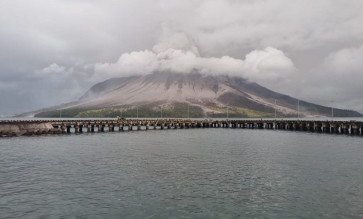Living with Batik from the Sultan's palace to the villages of Java
(JP/Kunang Helmi) French writer Elisabeth D
Change Size

(JP/Kunang Helmi)
French writer Elisabeth D. Inandiak settled down in Yogyakarta 17 years ago spending most of her time on the outskirts of the city, close to volcanic Mt Merapi.
Together with her teenage Indonesian daughter Sarah, she lives in two spacious wooden joglo style houses set back from the small street winding between rice-fields.
In 2006 when the earthquake struck the surroundings of Yogya, everyone had been actually preparing for another eruption of Mt Merapi, so that the other natural disaster took everybody by surprise. By chance the attention of Elisabeth was brought to the small village of Bebekan which was entirely destroyed by the violent tremors.
Thus began the saga of helping Bebekan residents help themselves and also her quest for funds and materials to build up the area again. Where Elisabeth herself resided suffered only minor consequences of the earthquake and so her attention was undivided, with Carrefour among those sponsors willing to help, together with a long list of her family, personal friends and acquaintances who set up a Bebekan fund in France.
Among the projects to revive the village and introduce new crafts was one where batik was involved. Another project is that of ecotourism with visitors coming to stay in the village of Bebekan's guest-house to spend a few days getting acquainted with life in a Central Javanese village.

A neighboring village of Bebekan near Imogiri has been renowned for batik making since many decades. Thus Elisabeth's idea of a batik exhibition with textiles using natural dyes began to grow. Fortunately the French travel agency Asia Voyages proved willing to provide the exhibition venue in Paris together with necessary funds to produce the new batiks on show.
The exhibition is the fruit of the collaboration of two important artisans of Yogyakarta: Ibu Sarjuni, the doyenne of batik tulis, whose workshop is to be found at the foot of the endless stairs leading up to Imogiri, where all the sultans of Java since the 17th century are buried; together with Pak Hendri Suprapto, whose Bixa atelier with thirty workers capable of using around 150 natural dyes, was involved with the dying of the batik patterns on both sides using the wax method. The work involving the batik production is on show in detailed video recording together with the batik cloth.
In Central Java, batik has been established for several centuries as a noble craft created by gifted artisans residing in the villages surrounding the courts of Yogyakarta and Surakarta. Among the chalk hills and the wide plains covered by rice-fields or sugar cane stretching out until the Indian Ocean, is where the knowledge, both popular and magic, which nourished the arts of the palaces of Java are to be found.
As to the region of Yogyakarta, here more than 1400 traditional motifs are to be found, either etched on the walls of hindu-buddhist temples of Prambanan or Borobudur and then re-formulated in the 16th century on the walls of some mosques on the north coast of Java. Each motif portrayed has a deeply symbolic significance and is associated with the various stages of birth, life and death of the Javanese people. Needless to say batik also accompanies life at the court such as dance, gamelan and shadow puppetry. The three traditional colors of Yogya batiks are indigo blue, soga brown and black (a mixture of indigo and soga).
About 150 years ago anilin chemical dyes from Germany distributed by Dutch traders flooded the batik market and the knowledge about natural dyes was gradually forgotten except for a few specialists. Chemical dyes were cheaper, more pratical and less time consuming than the natural dye processes.
The outstanding idea behind this show is the fact that natural dyes have been used to fabricate the batiks, reviving this ancient art while still using traditional Yogyakarta motifs. The batiks on display also portray the stages in the existence of a Javanese woman, from the time of gestation until her death and beyond.
Since four years Yogyakarta province has endeavored to note all the 1400 traditional motifs of batik in the region and to register them as its cultural heritage. The request that batik be registered as a national heritage by UNESCO, like the wayang kulit was in 2003 and the keris was in 2006, is pending.
Although Hendri Suprapto, founder of the small family firm called Bixa after the seeds of the bixa orellana which produce an orange tone, was not able to come to the opening, the iniator Elisabeth and representatives from the Indonesian Embassy in Paris were able to witness the opening of the show by president director of Asia Voyages Jean-Paul Chantraine.
The general public showed much enthusiasm and stormed to buy the batiks on display that very evening. However the buyers have to show patience because the show is travelling on to Lyon and only after it is over will they be able to enjoy their batik.









